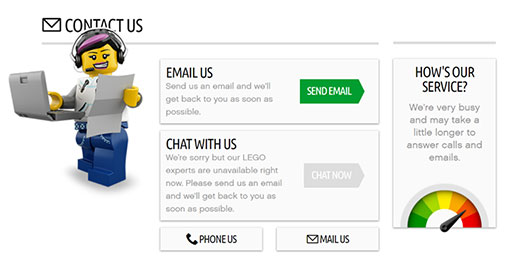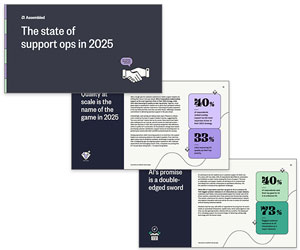We share some simple lessons for live chat forecasting before presenting a strategy that will help you to plan with minimal data to work from.
3 Common Misconceptions of Live Chat Planning
Live chat is becoming the channel of choice for many customers and, as they plan for this transition, many contact centres are making three key mistakes that are disrupting their forecasts.
- You can divide volume by concurrency (Wrong!)
- You can use a flat concurrency across the day (Wrong!)
- You can just use an Erlang calculator (Wrong!)
But why can you not do each of these three things?
Well, just because you are asking each team member to handle three chats at a time, you cannot assume that advisors will all be handling three consistently throughout the day.
With this in mind, you cannot just divide your projected chat volume by a consistent concurrency. That does not exist.
You need to remember that contact volumes are spiky and that throughout the day there will also be other factors that influence concurrency.
Rarely will advisors start the day by immediately taking on three chats, and at the end of their shift, you will also scale everything down.
“Rarely will advisors start the day by immediately taking on three chats, and at the end of their shift, you will also scale everything down,” says John Casey, a Resource Planning Expert at CCplanning.
Due to these changes in concurrency, you cannot use a standard Erlang Calculator for live chat planning, as – being developed for the voice channel – it assumes advisors are only handling one contact at a time.
With this in mind, a more sophisticated model is needed which looks at how frequently advisors deal with 1, 2, 3 etc. chats simultaneously across the day and the respective AHTs for each of those scenarios.
4 More Things You Need to Know About Live Chat Planning
You need to ensure that you do not make any of the three mistakes above, while you should also familiarize yourself with the four fundamentals of live chat planning below.
Once you understand each of these facts, you can devise a fool-proof strategy for forecasting and planning for live chat that you can develop over time, as you come to terms with your own trend and seasonality.
1. You Cannot Plan for Live Chat Until You Go “All In”
A lot of companies turn off their live chat channel when contact volumes become too high for advisors to handle, which does make a lot of sense in terms of moving customers to other channels with lower demand.

Lego are an example of a high profile company that turns chat off when contact volumes spike.
However, not only do you fail to meet customer expectations when doing this, it impedes your ability to forecast for the channel, according to John Casey.
John says: “If we don’t let contacts organically arrive, how will we ever know our true volume? This means that we will always be understaffing, we’ll always be behind the curve.”
So, while it may be scary to avoid the “turn live chat off” button at first, doing so will give you a much better idea for how you can forecast and staff in the future.
2. Advisor AHT Will Be Different Depending on Chat Concurrency
Average Handling Time (AHT) does increase as concurrency increases, making planning difficult. This is highlighted in the chart below.

C = Customer
A = Advisor
Q = Queue
In the above graphic, the single bar at the top shows a typical customer advisor–customer interaction and the time it takes for them both to type and send their responses.
The two bars underneath, which are joined together, demonstrate the pattern of the conversation when an advisor handles two chat interactions at once.
Now you can see that there is added time when the customer is forced back into the queue as they have responded quicker to the advisor than the advisor has to the other customer. This time is highlighted by the letter “Q” in the diagram.
This additional time prolongs each interaction, causing AHT to rise with concurrency, as you are adding queues into the interactions as well as before them.
If you add a third chat, it’s entirely possible that each customer will finish their response at around the same time and for two customers to be queuing within the interaction.
If you add a third chat, it’s entirely possible that each customer will finish their response at around the same time and for two customers to be queuing within the interaction.
Not only does this bring in customer experience considerations, in terms of planning, you need to think carefully about how you build this added queue time into your model.
3. Live Chat Planning Is Heavily Affected by the “Birth–Death” Syndrome
The “birth–death” syndrome, first theorized by Russian mathematician Andrey Markov, has since been reimagined for the contact centre, with a “birth” being recognized as the beginning of an interaction and a “death” signifying the end.
You can apply this logic to live chat so that each new interaction represents a “birth”. The number of births can reach as high a number as you have set as a cap for your business. However, there are also “deaths”, meaning that advisors won’t always be handling the same number of chats that equals your cap.
So, while an advisor can go forwards, from starting at one chat and moving to three, they can also go backwards, having three chats and moving back down to one, or even zero.
Knowing that AHT changes with concurrency, you can begin to understand just how volatile AHT is, according to John Casey.

John Casey
John adds: “The ‘birth–death syndrome’ means that we have to plan for when we are open. If we’re not open 24/7, assuming that when the team starts the day, they’ll be on the lower AHTs.”
“We then need to think about advisor breaks. If an advisor’s break is in ten minutes, can we plan and use the software to unwind, so that we wind down the advisor’s shift, so they go from handling three chats, to two, to one?”
4. Tolerance Has a Different Impact
While people are generally a lot more patient with live chat than they are with the phone, you still need to account for average patience in your forecasts, which is otherwise known as “tolerance”.
Tolerance considers the average time it takes for a customer to abandon, and you need to build that into your model, to ensure that you are not losing too many customers before they are put through to an advisor.
You can find a figure for tolerance by calculating the average time to abandon figure, which may be available within your chat system.
However, if it is not, you can also plot abandon curves to manually find a figure for average patience, which is the time it takes for 50% of chat customers to abandon.
As well as tolerance, you also need to account for shrinkage, as you cannot expect advisors to be in every day that you are open and spending 100% of their working day handling contacts. What about their holidays? Meetings? Sickness? etc.
For more on using shrinkage as a metric, read our article: How to Calculate Contact Centre Shrinkage
A Strategy for Live Chat Planning
For this example, let’s use the scenario that you are planning for a new live chat service, meaning that you have no existing data to work from.
However, if you have been using live chat for a while, using your existing data to provide insights into trend and seasonality will help you create even better forecasts.
Without this knowledge, there are a number of additional questions that you need to ask yourself, including:
- What percentage of our overall contact volume will now come through live chat?
- How will the addition of live chat influence overall contact volumes?
- Can we expect the take-up of live chat to increase over time?
To answer these questions, one method would be to get in touch with an organization with a similar customer demographic that has already implemented live chat and get this information from them.
Consult a Similar Organization With Live Chat
In this scenario, you should be asking the organization questions like: how many live chat contacts do you receive for every X amount of visitors to your website?
This ratio will help you to estimate and spot trends in how many contacts you are likely to receive throughout different parts of the day/week/month, according to the number of visitors to the site you receive.
The downside to this plan is that you will have to promote live chat in a very similar way to the organization you took this information from, as the number of contacts will depend very much on things like where the live chat icon is located on your website.
Over time, you can begin to create your own live chat model and experiment with how volumes are impacted by how the live chat channel is promoted on your site.
However, over time, you can begin to create your own live chat model and experiment with how volumes are impacted by how the live chat channel is promoted on your site.
You must, however, also consider what your AHT is, how it varies throughout the day and with concurrency. These are figures that you cannot take from another organization – your processes and procedures will vary greatly.
Run Live Chat Tests
To estimate AHT across live chat, one option is to start using live chat with a small team and limit the number of customers that you make this channel available to. By doing so, you can run all of your AHT tests in a controlled environment.
Also, this testing will enable you to find a figure for average patience, deepen your understanding of how many chats advisors can realistically handle at once and plan a strategy for winding concurrency up and down.
Then calculate shrinkage, target figures for service level and occupancy and then with all of this information, you can create a model for full roll-out.
Just remember to only turn off live chat as a last resort if your forecasts have underestimated contact volumes. Letting each contact come through naturally is how you can gain data to improve your forecasts in the future.
For more on forecasting with little data, read our article: How to Forecast With Minimal Data
In Summary
With no long-standing processes for forecasting and planning on live chat, organizations are trying many different methods for doing so, which have unfortunately led to many mistakes being made.
These mistakes stem from misconceptions such as: “you can divide concurrency by volume” and that “it’s alright to use an Erlang Calculator for staffing”. You can do neither of these things on the live chat channel.
So, you need to first familiarize yourself with the fundamentals of live chat planning before ou put together a model for live chat planning that is specific to your organization.
To do this, it is good to borrow data from other organizations – being wary of the pitfalls of doing so – and also to run tests to find key AHT insights, a figure for tolerance and an acceptable rate for concurrency.
Then, you also need to consider service level, shrinkage and occupancy. All of this information will allow you to develop a basic live chat planning model, which you can perfect over time.
Good luck!
For more content on forecasting and resource planning in the contact centre, read our articles:
- A Guide to Workforce Forecasting in the Contact Centre
- Resource Planning: What You Need to Know
- How Do I… Manage and Schedule Multi-Skilled Agents?
Author: Robyn Coppell
Published On: 6th Nov 2019 - Last modified: 14th Jul 2023
Read more about - Technology, Forecasting, Live Chat, Scheduling, Workforce Management (WFM)







































